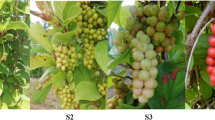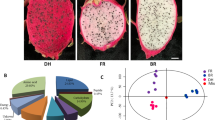Abstract
Lycium ruthenicum Murr. is an important ecological and economic species in the Qaidam Basin of Qinghai–Tibet Plateau. Its black fruits (BF) are rich in anthocyanins, which have health-promoting properties for humans and thus provide nutritional benefits for this plant. Although the fruit quality of natural white fruit (WF) is affected by the disappearance of pigmentation in phenotypes, this phenomenon provides an opportunity to unravel the complex color metabolic networks. In this study, anthocyanin profiling confirmed that WF was formed due to anthocyanin loss. Transcriptome analysis of BF and WF revealed 101,466 unigenes, 261 of which were identified as the putative homologs of color-related genes in other species. Genes encoding the enzymes involved in flavonoid biosynthesis were also identified systematically. The structural gene expression levels of chalcone synthase (CHS), chalcone isomerase (CHI), flavonoid 3′5′-hydroxylase (F3′5′H), dihydroflavonol 4-reductase (DFR), anthocyanidin synthase (ANS), and anthocyanidin 3-O-glucosyltransferase (UFGT) were highly similar and significantly positively correlated with anthocyanin accumulation rate in BF. In particular, F3′5′H, UFGT, ANS, and DFR expression levels in BF were 2391, 119, 96, and 85 times higher than those in WF at S3 (35 days after anthesis), respectively. This result strongly suggests that the low expression of these genes in WF is responsible for the anthocyanin loss. Meanwhile, the expression patterns of the anthocyanin regulatory genes were also investigated by qRT-PCR. Mass sequencing data were obtained and annotated by deep sequencing and provided a platform for future function and molecular biological research on L. ruthenicum Murr.




Similar content being viewed by others
References
Altintas A, Kosar M, Kirimer N, Baser K, Demirci B (2006) Composition of the essential oils of Lycium barbarum, and L. ruthenicum fruits. Chem Nat Compd 42(1):24–25
Bogs J, Jaffe FW, Takos AM, Walker AR, Robinson SP (2007) The grapevine transcription factor Vv MYBPA1 regulates proanthocyanidin synthesis during fruit development. Plant Physiol 143:1347–1361
Chiu LW, Zhou X, Burke S, Wu X, Prior RL, Li L (2010) The purple cauliflower arises from activation of a MYB transcription factor. Plant Physiol 154:1470–1480. https://doi.org/10.1104/pp.110.164160
Clark ST, Verwoerd WS (2011) A systems approach to identifying correlated gene targets for the loss of colour pigmentation in plants. BMC Bioinformatics 12(1):343. http://www.biomedcentral.com/1471-2105/12/343
Deroles S. Anthocyanin biosynthesis in plant cell cultures: a potential source of natural colourants (2009) In: Kevin G, Kevin D, Chris W, editors. Anthocyanins: biosynthesis, functions and applications. pp 107–117. New York, USA: Springer Science+ Business Media, LLC; p. 107–117
Espley RV, Brendolise C, Chagné D, Kutty-Amma S, Green S, Volz R, Putterill J, Schouten HJ, Gardiner SE, Hellens RP, Allan AC (2009) Multiple repeats of a promoter segment causes transcription factor autoregulation in red apples. Plant Cell 21:168–183. https://doi.org/10.1105/tpc.108.059329
Grotewold E (2006) The genetics and biochemistry of floral pigments. Annu Rev Plant Biol 57:761–780
Han YP, Vimolmangkang S, Soria-Guerra RE, Korban SS (2012) Introduction of apple ANR genes into tobacco inhibits expression of both CHI and DFR genes in flowers, leading to loss of anthocyanin. J Exp Bot 63:2437–2447
Jin X, Huang H, Wang L, Sun Y, Dai S (2016) Transcriptomics and metabolite analysis reveals the molecular mechanism of anthocyanin biosynthesis branch pathway in different Senecio cruentus cultivars. Front Plant Sci 7:1307. https://doi.org/10.3389/fpls.2016.01307
Katsumoto Y, Mizutani M, Fukui Y, Brugliera F, Holton T, Karan M et al (2007) Engineering of the rose flavonoid biosynthetic pathway successfully generated blue-hued flowers accumulating delphinidin. Plant Cell Physiol 48:1589–1600
Lou Q, Liu Y, Qi Y, Jiao S, Tian F, Jiang L, Wang Y (2014) Transcriptome sequencing and metabolite analysis reveals the role of delphinidin metabolism in flower colour in grape hyacinth. J Exp Bot 65(12):3157–3164
Miosic S, Thill J, Milosevic M, Gosch C, Pober S, Molitor C, Ejaz S, Rompel A, Stich K, Halbwirth H (2014) Dihydroflavonol 4-reductase genes encode enzymes with contrasting substrate specificity and show divergent gene expression profiles in Fragaria species. PLoS One 9(11):e112707
Peng Q, Song J, Lv X, Wang Z, Huang L, Du Y (2012) Structural characterization of an arabinogalactan-protein from the fruits of Lycium ruthenicum. Journal of Agricultural & Food Chemistry 60(37):9424–9429
Potterat O (2010) Goji (Lycium barbarum and L. chinense): phytochemistry, pharmacology and safety in the perspective of traditional uses and recent popularity. Planta Med 76(1):7–19
Qi YY, Zhu CY, Chen JF, Liu GY, Yang ZHW, Chen WSH (2019) Comparative analysis of the quality and health-promoting compounds of two-shaped fruits of wild Lycium ruthenicum Murr from the Qinghai–Tibet Plateau. Acta Physiologiae Plantarum 41:101
Saito R, Fukuta N, Ohmiya A, Itoh Y, Ozeki Y, Kuchitsu K, Nakayama M (2006) Regulation of anthocyanin biosynthesis involved in the formation of marginal picotee petals in petunia. Plant Sci 170:828–834
Salvatierra A, Pimente P, Moya-León MA, Herrera R (2013) Increased accumulation of anthocyanins in Fragaria chiloensis fruits by transient suppression of FcMYB1 gene. Phytochem Lett 90:25–36
Spitzer B, Zvi MMB, Ovadis M, Marhevka E, Barkai O, Edelbaum O, Marton I, Masci T, Alon M, Morin S, Rogachev I, Aharoni A, Vainstein A (2007) Reverse genetics of floral scent: application of tobacco rattle virus-based gene silencing in Petunia. Plant Physiol 145:1241–1250
Tanaka Y, Sasaki N, Ohmiya A (2008) Biosynthesis of plant pigments: anthocyanins, betalains and carotenoids. Plant J 54:733–749
Zeng S, Wu M, Zou C, Liu X, Shen X, Hayward A, Liu C, Wang Y (2014a) Comparative analysis of anthocyanin biosynthesis during fruit development in two Lycium species. Physiol Plant 150(4):505–516
Zeng S, Liu Y, Wu M, Liu X, Shen X, Liu C, Wang Y (2014b) Identification and validation of reference genes for quantitative real-time PCR normalization and its applications in Lycium. PLoS One 9(5):e97039. https://doi.org/10.1371/journal.pone.0097039
Zhang D, Xia T, Dang S, Fan G, Wang Z (2018) Investigation of Chinese wolfberry (Lycium spp.) germplasm by restriction site-associated DNA sequencing (RAD-seq). Biochem Genet 56:575–585
Zheng J, Ding C, Wang L, Li G, Shi J, Li H, Wang H, Suo Y (2011) Anthocyanins composition and antioxidant activity of wild Lycium ruthenicum Murr. from Qinghai-Tibet Plateau. Food Chem 126(3):859–865
Funding
This study was funded by the National Natural Science Foundation of China (Grant No: 31660221), Basic research project of Qinghai Province (Grant No. 2018-ZJ-713), and Construction Project for Innovation Platform of Qinghai Province (Grant No. 2017-ZJ-Y41).
Author information
Authors and Affiliations
Contributions
QYY and LXL initiated and designed the research. QYY, WHB, and GWY performed the experiments. QYY, SWJ, and DL analyzed the data. QYY and JLL revised the paper. All authors read and approved the final manuscript.
Corresponding author
Ethics declarations
Conflict of interest
The authors declare that they have no conflict of interest.
Additional information
Handling Editor: Peter Nick
Publisher’s note
Springer Nature remains neutral with regard to jurisdictional claims in published maps and institutional affiliations.
Rights and permissions
About this article
Cite this article
Qi, Y., Wei, H., Gu, W. et al. Transcriptome profiling provides insights into the fruit color development of wild Lycium ruthenicum Murr. from Qinghai–Tibet Plateau. Protoplasma 258, 33–43 (2021). https://doi.org/10.1007/s00709-020-01542-9
Received:
Accepted:
Published:
Issue Date:
DOI: https://doi.org/10.1007/s00709-020-01542-9




